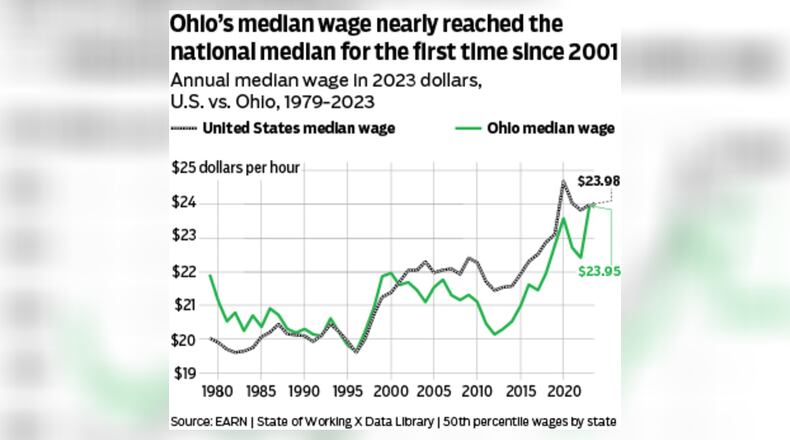“In 2023, Ohio experienced the largest annual increase in typical wages in decades. Unlike prior recoveries, the greatest percentage increases went to the lowest paid workers in the state,” the report said.
Workers in the bottom 20%, who were paid at or just above minimum wage, saw their median wages increase 11% between 2019-2023, the report found. Those workers had a median wage of $14.71 in 2023.
Workers in the top 20% had a median wage of $46.31 in 2023, a 3% increase from 2019.
While the report said growth in jobs helped workers demand wage increases that outpaced inflation, progress was constrained by “historical disparities in pay and power in the workplace.”
Among the findings:
- Median pay for Black workers in Ohio was $20.11 per hour, compared with $25.97 for white workers.
- Ohio women were paid 81 cents on the dollar compared to men.
- Wages for men grew faster than women’s and the gender pay gap persists, with males earning a median hourly wage of $25.99 and women $21.01.
- The median wage of a worker covered by a collective bargaining agreement in 2023 was $26.80 per hour compared to $23.06 per hour for non-union workers.
The report also said there were plenty of jobs for people to choose from in 2023, with the state recovering all jobs lost during the COVID-19 pandemic recession, as well as restoring all jobs lost during the early 2000s recession.
In July 2023 Ohio had more than 5.6 million workers and a 3.3% unemployment rate, the lowest since the data series began being collected in 1976, according to a news release from the Ohio Department of Job and Family Services. By July 2024 employment grew to nearly 5.7 million workers and unemployment rose to 4.5%.
The Policy Matters report also found that the federal spending on COVID-19 pandemic relief and stimulus fueled a jobs recovery in Ohio that occurred more quickly than after previous recessions.
“Federal cash support to families, and federally-funded investments in COVID recovery and infrastructure worked: The nation avoided a potentially devastating period of unemployment,” the report said.
Credit: Contributed
Credit: Contributed
“Smart, large-scale federal investments have put working people at the center of the ongoing recovery,” said Hannah Halbert, executive director and the report’s lead author. “Wage gains may appear larger on paper than they feel for many Ohio families, even as inflation cools.”
This year inflation is finally moderating after beginning to rise in 2021 as the nation and world grappled with pandemic economic disruptions. As measured by the Consumer Price Index, inflation grew 2.9 percent year-over-year in July, according seasonally adjusted data from the U.S. Bureau of Labor Statistics (BLS).
Monthly real average hourly earnings outpaced monthly inflation in eight of 13 months since July 2023, according to the BLS. Real earnings did not keep up with inflation in three of those 13 months and stayed even in two, the data show.
“If policymakers in D.C. and Columbus want to continue building toward shared prosperity, they need to focus on tax and budget policies that make it easier for working people and families to afford the cost of living — and the cost of going to work,” Halbert said.
Richard Stock, director of the University of Dayton’s Business Research Group, said federal stimulus spending did have a positive impact on Ohio jobs. But he said the federal government’s recent commitments to long term investment will have an even more powerful impact in Ohio over time.
Since 2021 Congress has approved the Infrastructure Investment and Jobs Act to fix roads, bridges, airports, and other infrastructure; the Inflation Reduction Act, which funded the economy, energy security, and climate; and the CHIPS and Science Act, aimed at boosting semiconductor production.
“The most obvious example of this is the massive $28 billion investment in two new state-of-the-art ‘chip plants,” Stock said, referring to the two Intel semiconductor plants being built in New Albany. “The infrastructure required for these plants will have a profound impact on every aspect of Ohio industry and education.“
Follow @LynnHulseyDDN on Facebook, Instagram, TikTok and X.
About the Author



